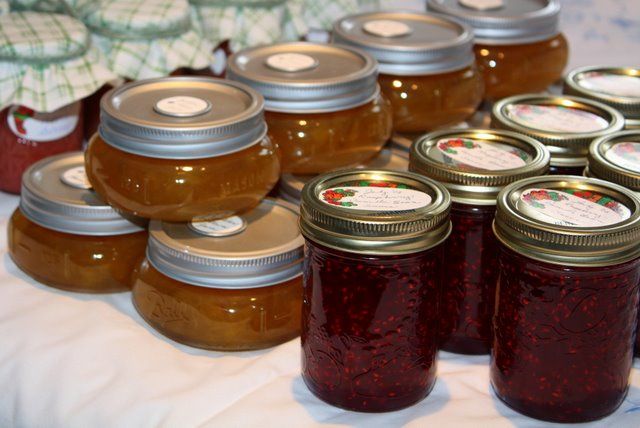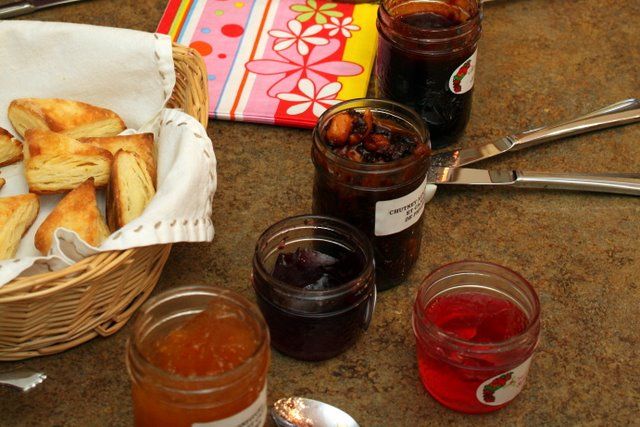My first attempt at making jam was memorable, for all the right reasons. I was a newlywed, eager to wear the old-fashioned housewife hat, and making my own jam seemed like something I would enjoy, more so than, say sewing curtains or darning socks. I had my flat of strawberries and set to work in my tiny apartment kitchen.
To my surprise, a little over an hour later I was looking at eight red jars of glistening strawberry jam. As I lay in bed that night, feeling mighty pleased with myself, I heard the blissful sound of the jars ‘popping’ as they sealed and I realized that I was no longer a jam novice—and I was hooked.
Although home food preserving is one of many dying arts, I’m confident that anyone can make jam. I would love to see preserving make a comeback. If I could do it, you can, too.
As with most new tasks, the first time always takes longer than anticipated, but jam-making is surprisingly easy. Worried about sterilizing? Simply run the jars through a cycle on your dishwasher and keep it on the hot drying setting until you’re ready to use them. Wondering about the wax with which your grandmother used to top her jam? Forget about it. This is no longer recommended, as mould can grow underneath the wax.
What about the processing-in-hot-water-business after the jars are filled? Yep, skip that too. As long as you are filling hot jars with hot jam and topping with a hot lid, and everything has been sterilized, there is no need for further processing (Note: this only applies to jam. Preserving other produce, such as vegetables or sauces, is a VERY different story).
First, let’s have a look at what goes into jam, then we’ll list tools needed, and finally finish with a quick look at the basic jam-making method.
Ingredients
Every jam consists of three main ingredients, with the amounts and ratios varying for different fruit, depending on their natural sweetness and juice content.
Fruit
Oh, the possibilities! Jam isn’t limited to just blushing berries or juicy stone fruit, although the classics are hard to beat. Try fig jam with a cheese tray, onion jam alongside roast pork, or a tart cranberry confiture. I’ve even heard of bacon jam.
Pectin
Available in liquid or powder, this natural thickener is often made from the rinds of citrus. Some well-known brands are Certo, Bernardin, and Ball. Liquid and powdered pectins can’t be used interchangeably, as each have their unique recipes; however, jams made with powdered pectin have triple the shelf life than those made with the liquid, and I usually choose to work with powder for this reason.
White Sugar
Sugar is a preservative as well as a sweetener. It should always be measured with a dry measuring cup and the amount never reduced, as it helps the jam to set properly.

Tools & Equipment
Fortunately, the start-up costs for making jam aren’t much — just the cost of your jars and a few tools. There’s no need to purchase a large canning pot—those are more for processing vegetables and sauces—and most jam recipes can be made in a large sauce pot. Here’s a starter list of what you’ll need; you probably own most of the items.
- Jars, lids and screw rings
- Lifter, for handling hot jars
- Funnel, for guiding hot jam into the hot jars.
- Glass measuring cup, for measuring crushed fruit and for pouring hot jam into hot jars.
- Wooden spoon, for stirring
- Timer—accurate cooking time is of the utmost importance.
- Sauce pot– this should be the largest one you own, as jam can froth up to three times its size when it is boiling. Also, a heavy-bottomed pot is helpful to prevent scorching or burning.
- Labels
- Several clean dish towels
- Also helpful, but not completely necessary, is what I call a magic canning wand

. It’s a plastic wand with a magnet on the end, useful for fetching the bot lids out of their water. Tongs also work well.
Basic Method for Making Jam
Prepare Equipment:
1. Assemble tools and equipment listed above.
2. Wash everything in hot, soapy water.
3. Sterilize. While I prefer to toss my jars in the dishwasher and run a cycle, others choose to wash them by hand and sterilize in the oven. This works well, too, and is an option if you don’t have a dishwasher. Simply wash the lids and jars in lovely hot soapy water, rinse, and place in a 9×13 pan. Put in a preheated, 225F oven for a minimum of ten minutes, until you are ready to fill them.
Prepare Fruit:
Whether you are stemming, pitting, peeling or seeding, this is the most time-consuming part of making jam. It can also be a fun job to involve the whole family, provided the toddler doesn’t consume all the produce.

1-2-3, CAN
- In a large saucepan, cook prepared fruit with pectin according to the recipe directions.
Add sugar and bring to a boil. - Remove from heat and skim off the foam.
- Ladle into hot jars.
- Cover with lids and screw the screw rings on tightly.
- Leave at room temperature for 24 hours without touching the jars, even if they “pop.”
Here is a tried and true recipe of mine for Golden Plum Jam to get you started, and you’ll find plenty more recipes in the links below:
So there you have it. You CAN can! Just wait, you’ll get bit by the canning bug too — soon, you’ll be designing your own labels, sewing frilly tops to decorate your jars with and swapping jam with friends.
There is nothing better than extending the taste of summer during those winter months, when fresh berries are a distant memory, to pop off a lid of home preserves. A word of warning, though — once you taste homemade jam, it’s difficult to go back to Smuckers.
One piece of advice — start small. Don’t be overly ambitious, or you could be discouraged by the results. Pick a simple recipe with just a few pints of fruit, and complete it from start to finish before purchasing a pallet of peaches.
What is stopping you from making your own home jams and jellies? Or if you’re an experienced jam maker, share your tips!


